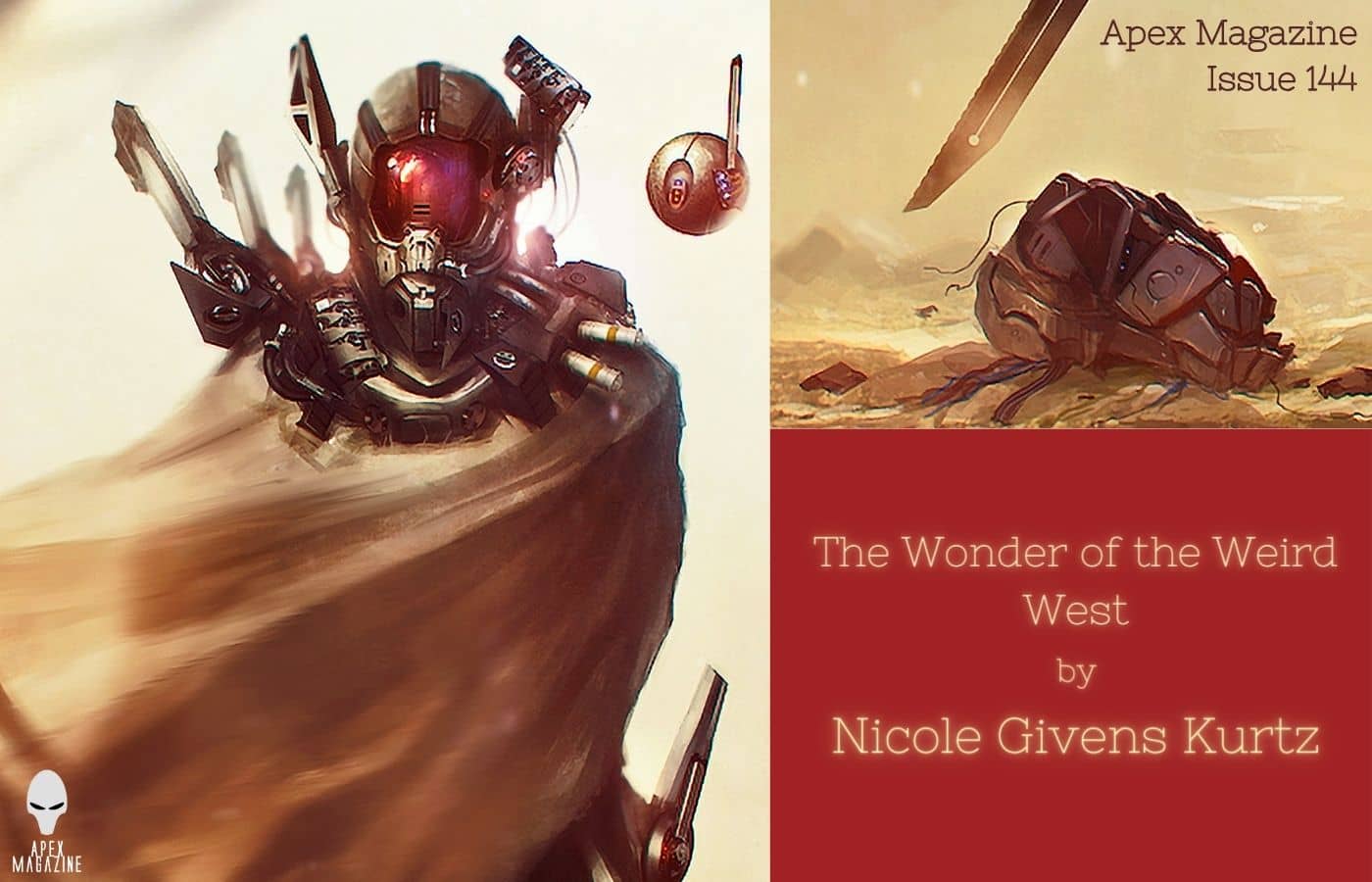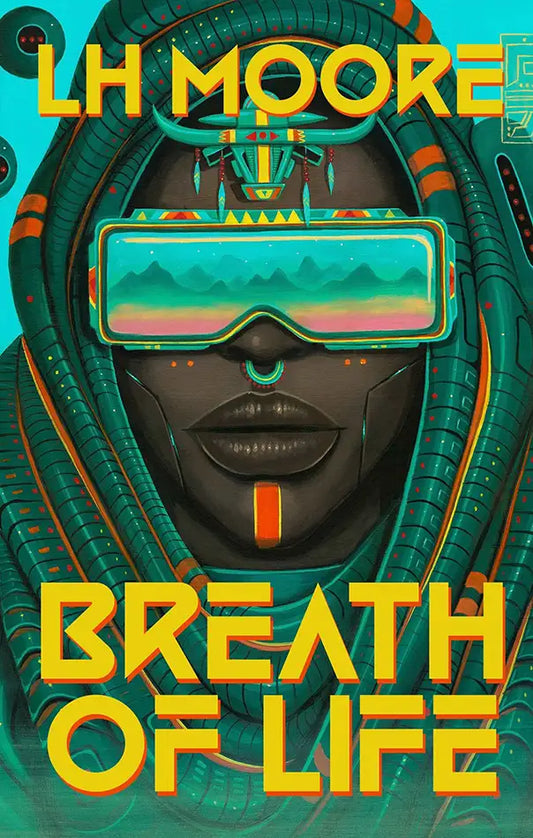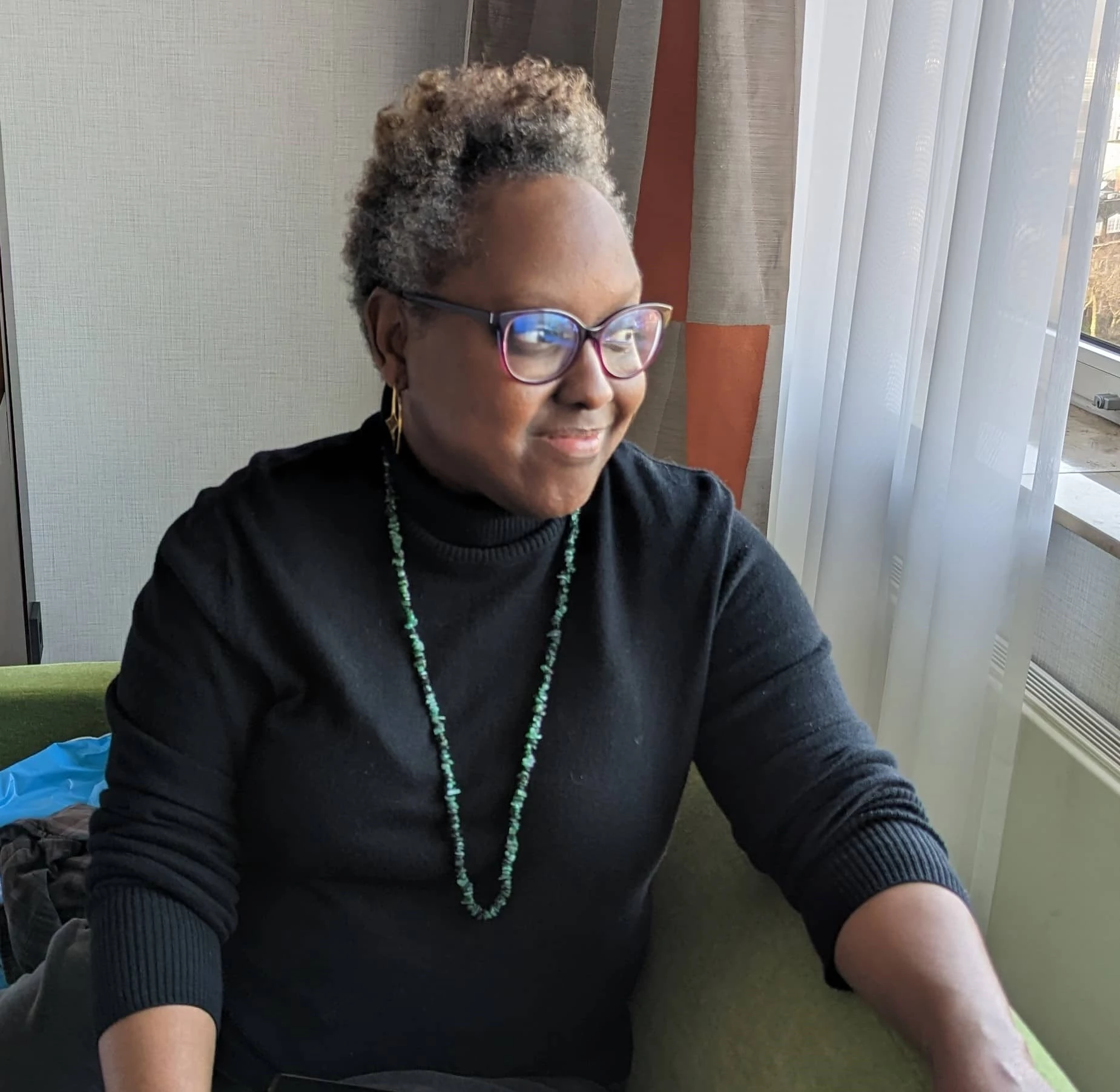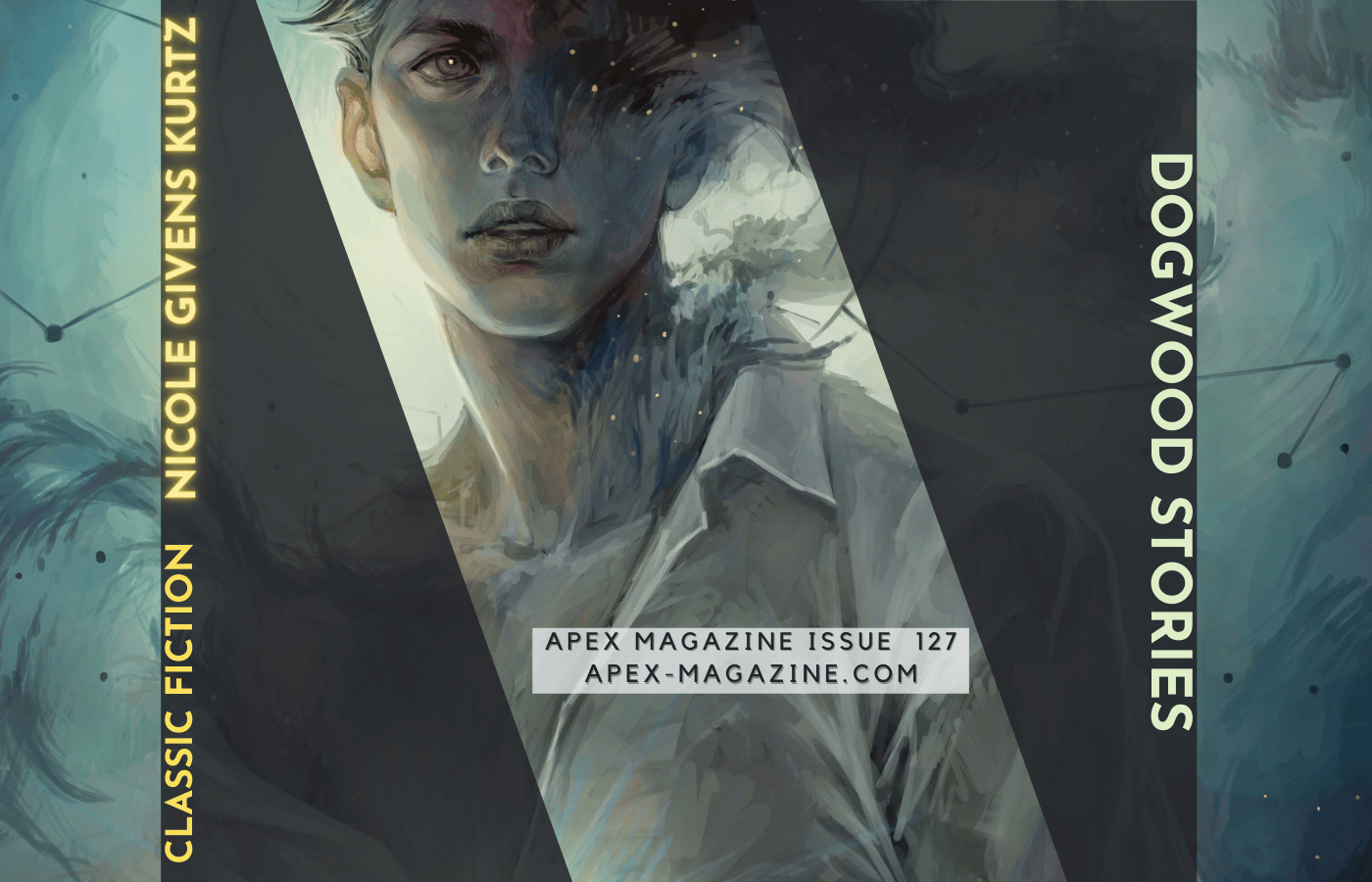
What’s a weird western? It’s a western story that incorporates strangeness—whether that be magic, aliens, or a mechanical spider—and wonder. How weird the American west must’ve been to freed slaves and women traveling from the East. People seeking adventure, land, gold, and freedom in the wilds of the western United States. It’s this sense of wonder, longing, wild curiosity, fed by the New Mexican landscape that lured me to the weird west.
I have always loved westerns.
The living room’s tube television rolled static before clearing to reveal a dusty town nestled in a desolate valley. The land is brown. The buildings are brown. The horses are brown. Like me. Clothes serve as the only splash of color. The elaborate and loud dresses belonged to the women of the night, and the faded glory outfits draped the homestead wives. Women were either temptresses or Madonnas.
I lived in a housing project for most of my young adult life. Magic, wonder, and weirdness remained far beyond my reach. Life bore more concrete ideals. Yet, my momma’s love for westerns was unfailing. Each night, she would settle down on the couch and watch, basking in the shoot outs, the hardships, the perseverance. I watched them with her, noting I rarely saw actual Black, Native Americans, or Asian Americans. The actors were always white actors in extremely poor makeup. Yellowface and redface occurred without any thought to how those representations impacted the communities in question.
To a young, Black teenager, they may as well have been on another planet.
After all, Star Trek was pitched as Wagon Train to the Stars.
What tethered us to westerns were the stories of resilience.
The west leveled the playing field. The upper crust and educated rules and elitist attitudes perished beneath the relentless sun and parched landscape. The bitter existence and the rough and tumble struggles of new towns and war left little room for societal etiquette and mores. The struggle was real for everyone. Despite how much money you had, life was hard for Blacks, Chinese, women, queer individuals, and Native Americans.
The early pioneers struggled in a foreign and different environment. Native Americans’ and Black Americans’ history in this country is well documented; however, I wouldn’t learn that during the 19th century, 1 in 4 people in the west were Black (Rancho Los Cerritos). Prejudice, harsh living conditions, and unprovoked violence were common. Both peoples know how the human spirit prevails and thrives despite heartbreak, racism, and pain.
I moved to Gallup, New Mexico in 2000, where I was able to physically touch magic by means of beautiful structures erected from the harsh environment, dip my fingers in the richness of the earth, red dust simmering in the flushed sunset, taste the fiery persistence of green chiles. The brown, dusty environment depicted on television by script writers paled in comparison to the brilliance of the high desert, summer monsoons, 50 inches of snow in the fall and winter, and the body changes courtesy of elevation. Life thrived in ways television lacked.
I was enchanted.
The landscape and the people invoked a sense of wonder and awe. I settled into the New Mexican way of life. It differed so much from my East Tennessee roots, but still remained somewhat familiar. It was this love for New Mexico, wedded to my love for westerns, that led me to weird westerns.
Encouraged by an invitation from the late David B. Riley, I wrote my first weird western for Six Guns Straight Outta Hell. I was won over by the dynamics of steampunk, aliens, and of course, magic in the west. Will Smith’s turn in The Wild Wild West movie conjured up all the western episodes from my past. The fact of a Black man in the west, saving it from destruction, stuck with me, despite the movie’s silliness. For once, the hero wore my color skin, and he was doing it with guns and a black hat—no white hat heroes here! (Traditionally, the villain wore black cowboy hats and the heroes wore white ones.
In the collection of weird western stories, Sisters of the Wild Sage: A Weird Western Collection, I chose to focus on the other people in the west. Freed slaves, Mexicans, and Dine (Navajo), Zuni, and primarily women—all individuals who have their own often overlooked or undiscovered magic and power. I listened to their voices and wrote their stories down for others to enjoy.
The historical aspects of weird westerns lie close to alternate history. Much of the American west’s history is subject to embellishment and hazy facts. After all, history is written by the victors. In the case of the west, one must dig beyond the tales of white American settlers to find other points of view. American television steadfastly depicted the western genre with a set list of archetypes and settings.
In the weird west, archetypes can be subverted, the setting relocated to space, to another dimension, to elsewhere. Yet the thrill of settling in a foreign place continues to invoke wonder and curiosity. Take for example, the anime/manga Trigun. Vash The Stampede, the protagonist, arrives on a desert planet after the crash of his spaceship—only he and his twin brother survive. The already inhabited world is comprised of other settlers and native creatures. Few humans are originally from the planet. The story and setting are steeped in western archetypes, from frontier towns to mechanical horses, and even Vash’s clothing and weaponry.
Another example of relocating the weird western’s setting beyond the physical location of the American west is Cannon Busters, an American comic adapted to an anime style series. The setting is on a planet where boom towns thrive, very similar to Trigun. The protagonist of the series is Gynoid Sam, a cyborg. Her companion is a robot. Their initial task is to capture the outlaw, Philly the Kid. The setting is filled with familiar western archetypes of saloons, jails, etc., but with futuristic elements, thus making it a weird western. The traditional western settings are subverted, and most of the characters are Black or BIPOC.
The Dark Tower series by Stephen King pushes the weird western genre to its farthest reach as Roland moves between different whens and wheres. The setting for each novel in the series shifted, along with Roland’s world. King describes this as worlds that have “moved on.” Members of Roland’s ka-tet (a group of fellow travelers) explore new locations and cultures as they move across time and places.
Their journey mirrors the stunned confusion and awe first explorers and adventurers may have felt when they migrated to the American west. Roland’s ka-tet encounter strange animals, such as lobsters who eat human fingers, and a parched landscape where crumbling cities and rusted machinery are scattered like sand. One could imagine people who saw the southwest, where gila monsters’ poisonous bites can dissolve flesh, and plants (cacti) are water reservoirs, would’ve been astounded. Roland, a weathered gunslinger, walks through a thinny (locations where people can step into different worlds) and finds himself in 1970s New York. The seasoned protagonist must navigate the foreign concrete frontier. It’s a subversion of the fish out of water in a remote landscape.
Weird westerns are often coupled with the protagonist’s complex backstory. Historically, travelers heading west or to a foreign frontier sought anonymity, and an opportunity to be the architects of their own lives. Many wanted to find wealth, land, and a new name or life, unburdened from the prejudices of the East and South. This was even more true during the Reconstruction Period after the American Civil War.
The lack of strict societal rules allows weird westerns’ heroes and heroines to occupy character gray space. They are neither traditional white hat heroes nor are they black hat villains. The western landscape leaves no room for such rigidness to survive. To thrive, to preserve often means committing acts once thought unthinkable.
The Mandalorian is a case in point. It’s been referred to as Star Wars’ answer to Lone Wolf and Cub. Mando’s journey and course of his life is altered when he obtains Grogu. Mando’s actions have been described as gray areas, but it is his curiosity and wonder about Grogu’s people, and how Grogu welds The Force, that launches Mando’s voyage across the galaxy.
That same sense of exploration propelled Star Trek: The Original Series’ five-year journey. The crew sought those new worlds and new civilizations, but it was their curiosity to explore the new frontier that drew millions to the franchise. Weird westerns provide an avenue to engage readers’ imaginations and invoke a sense of rugged playfulness in ways only speculative fiction can. The sub-genre is much more than dusty cowboys and gun battles. It’s the distillation of the human spirit deposited into the harshest environments and watching it soar.










